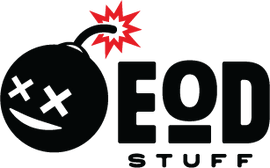· By Drew Billings
Skeebb™, Skuba Skeebb™ & More
The Skeebb?
Skeebb stands for Skeleton, Booze, and Bomb Dude—our fun, EOD-infused take on Skelly from Social Distortion.
The idea came to life when Kellie + Kurt (the OG EODStuff owners and operators) were making unit shirts for the USMC EOD Techs at Cherry Point, NC. The skeleton dude they sent over for screen printing had a solid Vietnam-era vibe, but we felt like it needed a little refresh. That’s when Kurt suggested modernizing Skeebb.
So, naturally, Kellie had Kurt throw on one of his old Mich helmets, snapped a pic, and we used that as the base for the new Skeebb design. She completely redrew the skeleton, the bomb, and the booze bottle, turning Skeebb into his own little legend.

What Skeebb Means to Us
Skeebb is more than just a design—it's' the (un)official mascot of EOD.
So, whether you’re rocking Skeebb on a tee, a patch, or a sticker, just know it stands for something real. Here’s to keeping the tradition alive. 🍻💣💀
